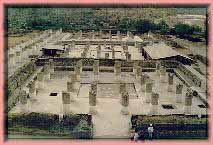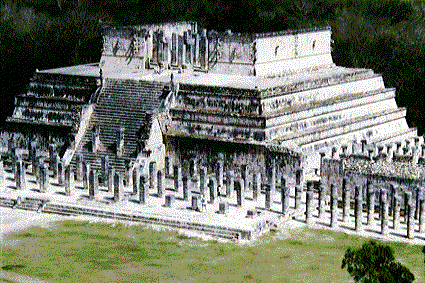
Under Quetzalcoatl's Leadership, the Toltecs built an impressive
metropolis at Tula. The architectural style was visually dramatic and
innovative. Stately columns provided elegant walkways for the warriors
who gathered for important ceremonies. The columns were also used as
structural supports for the larger temple rooms that were needed for group
activities. The temple entrances were framed by great, serpent-columns
which supported massive lintels across each entrance. Their open jaws
extended forward to flank the temple doorway, their bodies formed the
sides, and their tails swept up in a squared S-shape to support the
framework of the door.
The Transition from the small, exclusive temples of the Classic period to
these open, colonnaded structures of the Postclassic, reflects the changing
times. The new temples were built for active group participation while
the temples of the Classic Period were only used by the priests. However,
as impressive in design as these new buildings were, inferior building
materials were used, and the clay bricks and coarse stones soon succumbed
to the ravages of time. These Toltec temples were evidently very rapidly
constructed to accommodate the needs of a large population, rather than
painstakingly built to last through the centuries.

The Toltec/Maya at Chichen Itza
Splinter groups of the Toltec warriors began to migrate beyond their
territorial boundaries in the Valley of Mexico long before Quetzalcoatl's
abdication. There is evidence that their explorations extended as far as
the Maya homeland, on the Yucatan Peninsular, several times during the 10th
century. According to the Mayan Chronicles in the books of Chilam Balam,
one very special group of Toltec invaders came to the Yucatan in the year
of Quetzalcoatl's abdication and conquered the ancient Maya city of
Chicen. They were led by a high Priest called "Kulkulcan", the Maya word
meaning "Plumed Serpent". There is no evidence that Kulkulcan and
Quetzalcoatl were the same man. The records for this invasion indicate
that Kulkulcan was a bloodthirsty conqueror far different from the gentle
leader at Tula who bore the same name. The only proven fact is that a
band of Toltec warriors, led by a man called Kulkulcan, arrived in Chichen
Itza in A.D. 987.
The Toltecs, who came to Chicen Itza, built a whole new section in the
ancient Maya City they conquered, and recreated the image of Tula. Some
of the striking similarities between the two cities are: the extensive
use of the column in architecture, serpent-form columns to flank temple
entrances, reclining Chacmool figures, tzompantlis, and jaguar and eagle
symbols that identify the warrior orders of the Toltecs.




